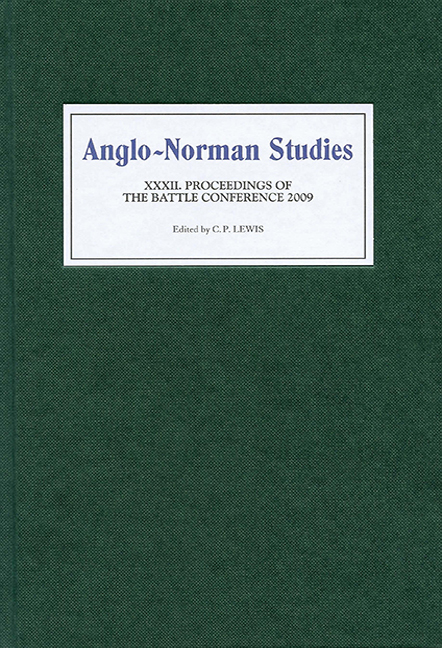Book contents
- Frontmatter
- Contents
- List of Maps and Tables
- Editor's Preface
- Abbreviations
- The Peace of God and Bishops at War in the Gallic Lands from the Late Tenth to the Early Twelfth Century
- Ad erudiendum tradidit: The Upbringing of Angevin Comital Children
- Coming and Going: The Use of Outdoor Space in Norman and Anglo-Norman Chronicles
- The Urban Transformation in England, 900–1100
- The Taming of the Laity: Writing Waltheof and Rebellion in the Twelfth Century
- Close Relations? Some Examples of Trade Links between England and the Towns and Ports of Lower Normandy in the Thirteenth and Early Fourteenth Centuries
- The Roots of the English Royal Forest
- Knighthood and Chivalry in the Histories of the Norman Dukes: Dudo and Benoît
- Prayers for the King and Royal Titles in Anglo-Norman Charters
- Domesday Mortlake
- Miscellaneous Endmatter
Coming and Going: The Use of Outdoor Space in Norman and Anglo-Norman Chronicles
Published online by Cambridge University Press: 28 April 2017
- Frontmatter
- Contents
- List of Maps and Tables
- Editor's Preface
- Abbreviations
- The Peace of God and Bishops at War in the Gallic Lands from the Late Tenth to the Early Twelfth Century
- Ad erudiendum tradidit: The Upbringing of Angevin Comital Children
- Coming and Going: The Use of Outdoor Space in Norman and Anglo-Norman Chronicles
- The Urban Transformation in England, 900–1100
- The Taming of the Laity: Writing Waltheof and Rebellion in the Twelfth Century
- Close Relations? Some Examples of Trade Links between England and the Towns and Ports of Lower Normandy in the Thirteenth and Early Fourteenth Centuries
- The Roots of the English Royal Forest
- Knighthood and Chivalry in the Histories of the Norman Dukes: Dudo and Benoît
- Prayers for the King and Royal Titles in Anglo-Norman Charters
- Domesday Mortlake
- Miscellaneous Endmatter
Summary
Conceptions of space in eleventh- and twelfth-century Norman and Anglo-Norman chronicles were complex. They encompassed the natural environment, political relationships, and more abstract notions, such as the links between this world and the next. Central to their understanding was the movement of people through and around the landscape. The roads, rivers, and watercourses they travelled allowed the chroniclers to link different areas geographically and conceptually, adding to our knowledge of how these writers structured their narratives and how they understood medieval society. In order to explore the chroniclers’ use of outdoor space and what it meant, I will examine four areas: descriptions of the landscape, particularly of Normandy and of England during the Harrying of the North; the visibility of the past as described through the remains of buildings and other monuments; times of regional crisis on which the fate of Normandy hung, notably the battles of Val-ès-Dunes and Varaville; and, finally, times of more personal crisis, revealing the spatial link between this world and the next. These examples are drawn from a number of different chronicles reflecting diverse reasons for writing, including histories of the Normans, William of Poitiers's biography of William the Conqueror, Orderic Vitalis's Ecclesiastical History, and William of Malmesbury's Gesta Regum Anglorum, the history of a realm. In my consideration of these areas some common themes emerge. Roads and other routes posed difficulties which had to be overcome: many were poorly maintained and the margins of roads were often hiding places for robbers and other undesirables. They were also sites of possibility, with the potential for change on both a personal and a larger scale. Finally, travel and movement were also dependent on the maintenance of order and authority within a particular region. It is no coincidence that times of peace are often described with reference to the ease with which travellers could negotiate various routes. Travel and commerce depended on a particular ruler's ability to maintain his or her authority in localities far from the caput of that territory. Roads carried that authority, connected the places within a territory, and helped make authority manifest in the landscape.
Movement of people in the chronicles, both physically and mentally, is essential, as it allows us to see different places and spaces.
- Type
- Chapter
- Information
- Anglo-Norman Studies XXXIIProceedings of the Battle Conference 2009, pp. 40 - 56Publisher: Boydell & BrewerPrint publication year: 2010

